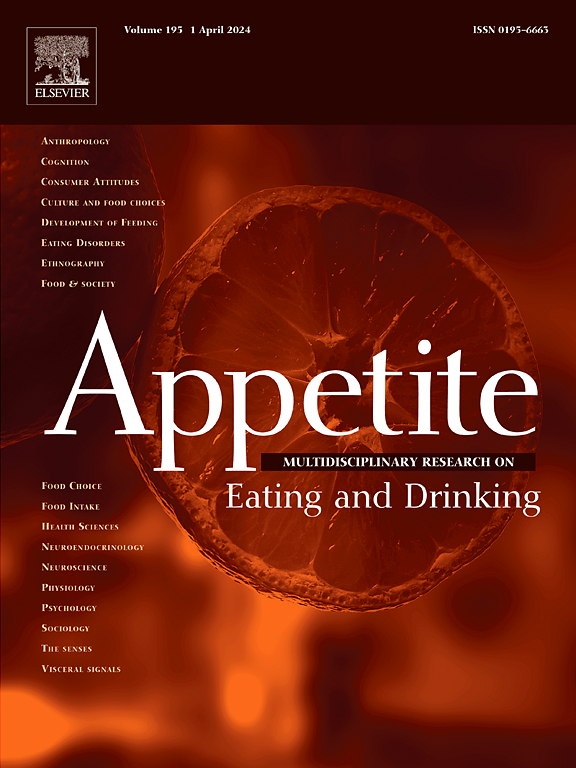在辅食喂养过程中向婴儿提供过敏原食物的家长报告:对新西兰婴儿的观察研究。
IF 4.6
2区 医学
Q1 BEHAVIORAL SCIENCES
引用次数: 0
摘要
新西兰婴儿的食物过敏发病率尚不确定,但据信与澳大利亚相似,超过10%。目前降低食物过敏风险的建议是,最早从婴儿六个月大(开始添加辅食)开始,在 12 个月大之前为其提供所有主要的食物过敏原。然而,人们对家长引入主要食物过敏原的做法知之甚少。本研究旨在探讨家长在辅食喂养期间向婴儿提供主要食物过敏原的情况,以及家长报告的食物过敏情况。这项横断面研究是对新西兰第一食品公司的多中心(奥克兰和达尼丁)研究进行的二次分析。参与者于 2020-2022 年婴儿 7-10 个月大时被招募。调查问卷评估了社会人口特征、辅食喂养方式、婴儿袋使用情况以及父母对五个食物过敏问题的回答。只有 17% 的婴儿在 9-10 个月大时食用过所有主要的食物过敏原。使用婴儿主导型辅食喂养法比使用父母主导型辅食喂养法更常见(P<0.05)。本文章由计算机程序翻译,如有差异,请以英文原文为准。
Parent-reported offering of allergen foods to infants during complementary feeding: An observational study of New Zealand infants
The prevalence of food allergies in New Zealand infants is uncertain but is believed to be similar to Australia, exceeding 10%. Current recommendations for reducing food allergy risk are to offer all major food allergens to infants from as early as six months of age (start of complementary feeding), and before 12 months of age. However, little is known regarding parental practices around introducing major food allergens. This study aimed to explore parental offering of major food allergens to infants during complementary feeding, and parent-reported food allergies. The cross-sectional study is a secondary analysis of the multi-centre (Auckland and Dunedin) First Foods New Zealand study of 625 parent-infant dyads. Participants were recruited in 2020–2022 when infants were 7–10 months of age. Questionnaires assessed sociodemographic characteristics, complementary feeding approach, infant pouch use and parental responses to five food allergy questions. All major food allergens had been offered to only 17% of infants by 9–10 months of age. Having offered egg, peanut, tree nuts, sesame, soy and seafood was more commonly associated with using a baby-led complementary feeding approach than a parent-led approach (p < 0.001). Frequent baby food pouch use was associated with a lower likelihood of offering egg and peanut (both p < 0.001). Overall, 12.6% of infants had a reported food allergy, with symptomatic response after exposure being the most common diagnostic tool. Most infants are not offered all major food allergens during early complementary feeding, with some parents actively avoiding major food allergens in the first year of life. These results provide up-to-date knowledge of parental practices, highlighting the need for more targeted advice and strategies to improve parental engagement with allergy prevention and diagnosis.
求助全文
通过发布文献求助,成功后即可免费获取论文全文。
去求助
来源期刊

Appetite
医学-行为科学
CiteScore
9.10
自引率
11.10%
发文量
566
审稿时长
13.4 weeks
期刊介绍:
Appetite is an international research journal specializing in cultural, social, psychological, sensory and physiological influences on the selection and intake of foods and drinks. It covers normal and disordered eating and drinking and welcomes studies of both human and non-human animal behaviour toward food. Appetite publishes research reports, reviews and commentaries. Thematic special issues appear regularly. From time to time the journal carries abstracts from professional meetings. Submissions to Appetite are expected to be based primarily on observations directly related to the selection and intake of foods and drinks; papers that are primarily focused on topics such as nutrition or obesity will not be considered unless they specifically make a novel scientific contribution to the understanding of appetite in line with the journal's aims and scope.
 求助内容:
求助内容: 应助结果提醒方式:
应助结果提醒方式:


